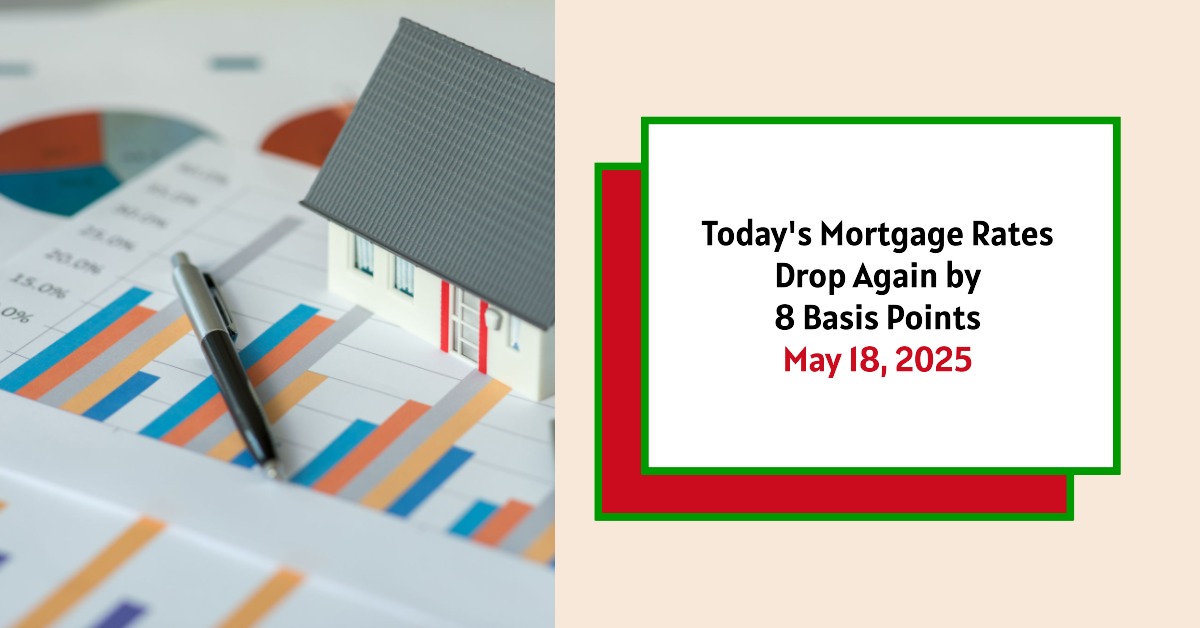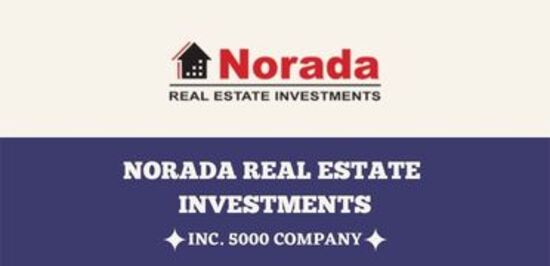As of May 18, 2025, mortgage rates have decreased, presenting a more favorable environment for home buyers and those considering refinancing their existing loans. The average 30-year fixed interest rate is now at 6.77%, down eight basis points, while the 15-year fixed rate has fallen to 6.03%, a decline of ten basis points. This trend is encouraging and may motivate potential buyers to engage more actively in the housing market.
Today's Mortgage Rates – May 18, 2025: Rates Go Down Again by 8 Basis Points
Key Takeaways:
- Mortgage Rates: Average 30-year fixed rates at 6.77% and 15-year fixed rates at 6.03%.
- Refinance Rates: 30-year refinance rates at 6.97%; 15-year refinance rates at 6.25%.
- Economic Trends: The current decreases in rates suggest stabilization in the economy, potentially leading to more decisions in home purchases and refinancing.
Current Mortgage Rates
As home buying seasons often heat up around this time of year, here’s a summary of the current mortgage rates observed today:
| Type of Mortgage | Rate (%) |
|---|---|
| 30-Year Fixed | 6.77% |
| 20-Year Fixed | 6.25% |
| 15-Year Fixed | 6.03% |
| 5/1 Adjustable Rate Mortgage | 7.08% |
| 7/1 Adjustable Rate Mortgage | 7.40% |
| 30-Year VA | 6.31% |
| 15-Year VA | 5.64% |
| 5/1 VA | 6.29% |
Source: Zillow
These rates represent the national averages and may vary based on the lender and specific borrower circumstances.
Current Mortgage Refinance Rates
For those looking to refinance, here are the average rates for refinancing observed today:
| Type of Refinance Mortgage | Rate (%) |
|---|---|
| 30-Year Fixed | 6.97% |
| 20-Year Fixed | 6.64% |
| 15-Year Fixed | 6.25% |
| 5/1 Adjustable Rate Mortgage | 7.56% |
| 7/1 Adjustable Rate Mortgage | 7.51% |
| 30-Year VA | 6.47% |
| 15-Year VA | 6.17% |
| 5/1 VA | 6.37% |
Source: Zillow
Mortgage refinance rates often exceed purchase mortgage rates due to different loan payback structures and borrower advantages, but the current trends show competitive offerings that could benefit those looking to refinance.
Understanding Mortgage Types: Fixed vs. Adjustable
Mortgage options can be broadly classified into fixed-rate and adjustable-rate mortgages (ARMs).
- Fixed-Rate Mortgages: The interest rate remains constant throughout the life of the loan, making it easier for borrowers to plan their budgets, as monthly payments remain predictable. The most popular fixed-rate mortgage is the 30-year term because it spreads the loan amount over a longer period, resulting in lower monthly payments. For instance, with a $300,000 mortgage at the current 6.77% rate for 30 years, your monthly payment would be approximately $1,950, which translates to $401,922 paid in interest over the life of the loan.
- Adjustable-Rate Mortgages: Conversely, ARMs start with a lower initial rate that adjusts after a specified period. For example, a 7/1 ARM has a fixed rate for the first 7 years and then adjusts annually based on market conditions. While ARMs can offer lower initial rates, there is a risk that payments may increase significantly if rates rise after the initial period. To illustrate, if the initial rate is 4% for the first 7 years and then increases by 2%, future payments could dramatically impact a homeowner’s budget.
Strategies for Securing Lower Rates
If you're in the market for a mortgage, there are strategies to secure the best possible rate.
- Compare Lenders: Don’t settle for the first offer you receive. It’s wise to apply for preapproval with multiple lenders—ideally three to four. This not only gives you various options but also helps you understand what rates you may qualify for given your unique financial circumstances, including credit scores and debt-to-income ratios.
- Understand APR vs. Interest Rate: When comparing loans, be sure to look closely at the Annual Percentage Rate (APR), which factors in the interest rate plus any additional fees that might come with the loan. The APR provides a clearer picture of what you will actually pay over the loan’s lifespan, as it reflects the true annual cost of borrowing.
- Consider Discount Points: Buying discount points may enable you to lower your long-term interest rate by paying a little extra upfront. Each point typically costs 1% of the mortgage amount and generally reduces the rate by 0.25%. If you plan on staying in your home long enough to recoup these costs through your lower monthly payments, this option might be worth considering.
Economic Influences on Mortgage Rates
Understanding that while mortgage rates are currently trending downward, various economic indicators can influence future adjustments is crucial. Keeping an eye on these factors informs both buyers and investors about potential fluctuations in rates.
- Inflation and Employment: Inflation is a key determinant of interest rates. As inflation rises, buyers often face higher rates, because lenders also raise their rates to offset the potential decline in the purchasing power of money. Conversely, if the labor market begins to show signs of weakness, mortgage rates might decrease in anticipation of slower economic growth. Historically, rates tend to decline during recessions when investors flock toward safer assets and the Federal Reserve lowers the federal funds rate in an effort to stimulate borrowing.
Read More:
Mortgage Rates Trends as of May 17, 2025
Dave Ramsey Predicts Mortgage Rates Will Probably Drop Soon in 2025
Future of Mortgage Rates Post-Fed Decision: Will Rates Drop?
Fed's Decision Signals Mortgage Rates Won't Go Down Significantly
Future Projections
Looking forward, predictions from the Mortgage Bankers Association (MBA) and Fannie Mae highlight how rates might change in the coming months. Here are their expected averages for the next few quarters:
| Forecaster | Q2/25 | Q3/25 | Q4/25 | Q1/26 |
|---|---|---|---|---|
| Fannie Mae | 6.5% | 6.3% | 6.2% | 6.1% |
| MBA | 7.0% | 6.8% | 6.7% | 6.6% |
These projections suggest a gradual decline in rates over the next few quarters, presenting opportunities for buyers and refinancers alike. However, it’s important to approach these forecasts with caution, as economic unpredictability can result in abrupt changes in the mortgage market.
Calculating Monthly Payments
Understandably, the distinction between various mortgage options leads to different financial obligations on a monthly basis. Using a standard mortgage calculator can help you visualize potential payments under different scenarios. For example, let’s calculate potential monthly payments for a $300,000 loan under varying rates:
- 30-Year Fixed at 6.77%:
- Monthly payment: $1,950
- Total interest after 30 years: $401,922
- 15-Year Fixed at 6.03%:
- Monthly payment: $2,536
- Total interest after 15 years: $156,558
- 7/1 ARM starting at 4.00%:
- Monthly payment for first 7 years: $1,432
- Total interest (if rates rise to 6% after the initial period): Future payments would vary based on market adjustments.
These calculations provide an essential perspective on how different mortgage types can affect total out-of-pocket expenses over time.
Understanding the Home Buying Process
Navigating the home-buying process can sometimes be overwhelming, especially when it comes to understanding mortgage rates and lender options. Begin by assessing your financial health, including credit score and existing debts, which will ultimately influence the rates you’re offered.
Deciding on a budget crucially determines the price range you can consider while house hunting. Don't forget to include potential homeowner insurance, property taxes, and maintenance costs in your total budget. These factors provide a more realistic view of your overall financial responsibilities, helping to avoid potential pitfalls in the future.
The Bottom Line
As we observe today, mortgage rates are lower—an encouraging sign for both prospective homebuyers and those contemplating refinancing. The continuous assessment of economic conditions will play a vital role in how these rates might change moving forward. Understanding your options and being proactive in comparing lenders will immensely benefit you in getting favorable mortgage terms.
Invest Smarter in a High-Rate Environment
With mortgage rates remaining elevated this year, it's more important than ever to focus on cash-flowing investment properties in strong rental markets.
Norada helps investors like you identify turnkey real estate deals that deliver predictable returns—even when borrowing costs are high.
HOT NEW LISTINGS JUST ADDED!
Connect with a Norada investment counselor today (No Obligation):
(800) 611-3060
Also Read:
- Will Mortgage Rates Go Down in 2025: Morgan Stanley's Forecast
- Expect High Mortgage Rates Until 2026: Fannie Mae's 2-Year Forecast
- Mortgage Rate Predictions 2025 from 4 Leading Housing Experts
- Mortgage Rates Forecast for the Next 3 Years: 2025 to 2027
- 30-Year Mortgage Rate Forecast for the Next 5 Years
- 15-Year Mortgage Rate Forecast for the Next 5 Years
- Why Are Mortgage Rates Going Up in 2025: Will Rates Drop?
- Why Are Mortgage Rates So High and Predictions for 2025
- Will Mortgage Rates Ever Be 3% Again in the Future?
- Mortgage Rates Predictions for Next 2 Years
- Mortgage Rate Predictions for Next 5 Years
- Mortgage Rate Predictions: Why 2% and 3% Rates are Out of Reach
- How Lower Mortgage Rates Can Save You Thousands?
- How to Get a Low Mortgage Interest Rate?
- Will Mortgage Rates Ever Be 4% Again?



